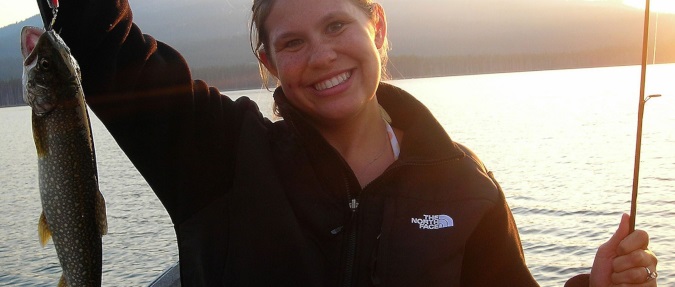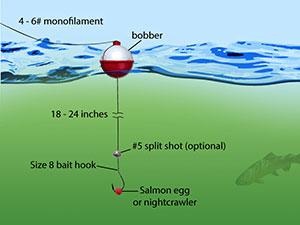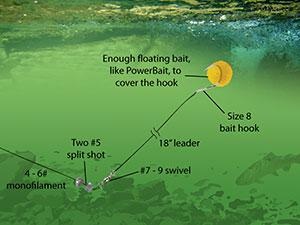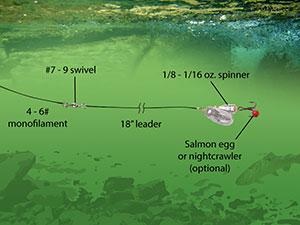
More people in Oregon fish for trout than for any other kind of fish. Anglers can experience a lifetime of varied and rewarding adventures fishing for trout in Oregon’s shaded coastal streams, alpine lakes, urban ponds and high desert rivers.
Where and when to fish
Trout are widely distributed and can be found in almost any water body that provides:
- cool, clean water
- food – such as aquatic insects, minnows and crawfish
- cover and protection from predators
Trout habitats are often divided into lakes and ponds (still waters) or rivers and streams (moving waters). Fish location, behavior and fishing tactics will vary depending on whether you’re fishing in still waters or moving waters.
Finding trout in lakes and ponds
In still waters trout are on the move, “cruising” the water looking for food. At the same time, trout don’t want to get too far away from cover that offers protection from predators. Some likely places to look for trout in lakes and ponds include:
- near or above aquatic vegetation
- around logs, stumps, rocks or other structure at stream inlets where streams flowing into the lake or pond are bringing cool, fresh water and likely a supply of food
- deeper waters, especially in the warm summer months when trout are looking for cooler water as well as protection from overhead predators
The best time of year to trout fish in lower elevation lakes is in the spring and fall when the water is cooler and the trout are more active. This also is when most lakes are stocked. In the warm summer months, anglers can look for trout in cooler, deeper waters, or in high mountain lakes that remain cool year-round. In warmer parts of the state, such as the Willamette Valley or along the coast, trout fishing in lakes or ponds can be good well into the winter months – for anglers hardy enough to brave cold and wet weather.
Finding trout in rivers and streams
In moving waters, trout tend to hold in one spot and wait for the water current to bring food to them. A primary food source for these fish is aquatic insects adrift in the current. In addition to looking for food and protection from predators, trout in moving waters are also looking for a place to rest from the current. So some likely places to look for trout in rivers and streams include:
- behind rocks or other structure (Look for water where the surface is textured with bumps or riffles, which are often created as water flows over rocks and boulders on the river bed.)
- near steep or undercut banks
- in deeper, slower pools
Most rivers and streams fish best in the spring and fall when water temperatures are cooler. Few rivers and streams are stocked, so you’ll likely be fishing for naturally reproducing or wild fish. As the water gets warmer, look for trout in faster riffles where the water gets re-oxygenated as it tumbles over rocks. Some rivers, especially in central Oregon, are open for trout year-round. Fishing can be good in the winter months – for hardy anglers willing to brave the cold and snow – but look for trout in slow, calm waters where they don’t have to fight the current.
Tackle for trout fishing
The list of necessary trout fishing gear and equipment can be very simple. A rod and reel, and a small selection of lures, bait hooks, bobbers and artificial bait is enough to go fishing just about anywhere you might find trout. A good shopping list to get started might include:
- A lightweight 6-foot spincasting or spinning rod with matching reel and 4-6 pound monofilament line
- A handful of 1/16 oz. spinners
- Package of size 8 bait hooks
- Couple of red/white bobbers
- Jar of PowerBait or PowerEggs
- A package of #5 lead split shot
- Worms
Fly-fishing is another popular way to fish for trout. It requires more specialized equipment and tools, but a good starter outfit could include:
- Graphite 5-weight fly rod, 9 feet long
- Matching fly reel
- Weight forward, 5-weight fly line
- Tapered monofilament leaders, 4x 7.5 feet long
- Spools of 4x and 5x tippet
- Assorted streamside tools
- Flies
Fishing techniques for lakes and ponds
There are lots (and lots) of ways to fish for trout, but three of the easiest ways to fish for trout in lakes are:
- Suspending bait under a bobber. Start with a piece of worm or a little PowerBait or similar product on a bait hook. Attach a small, lead weight just above the hook to help the bait sink, and add a bobber 1 ½ to 3 feet above the hook. Cast out to a likely spot and wait for the bobber to wiggle, dive or jerk. This is a good technique when fish are cruising nearer the surface or when you want to keep your bait and hook suspended above a weed bed.
- Fishing with bait off the bottom. Sometimes trout are in deeper water and the bait needs to be down deep where the fish are. In this technique there is no bobber to suspend the bait. Instead the lead weight is attached about 1 ½ feet above the baited hook and cast out. The lead weight will sink, but the bait will float up and hover 1 ½ feet above the bottom of the lake.
- Retrieving a spinner, spoon or fly. Spinners mimic small minnows, leeches and other favorite trout food. When fishing a spinner or spoon, cast it over trout-habitat-looking water. Let it sink for a minute then begin reeling it in (retrieving). Vary the amount of time you let the spinner sink and the speed of the retrieve until you find the combination that catches fish.
Fishing techniques for rivers and streams
In moving water it is the current, instead of your retrieve, that will affect how your lure moves in the water. Some good trout fishing techniques for moving waters include:
- Casting a spinner or spoon. Begin by casting the spinner slightly upriver and reel in any slack line.
- As the current carries the spinner down river, hold as much fishing line off the water as you can to achieve a natural “drift.” Once the spinner has swung toward the shore and is straight down river, begin a moderate retrieve.
- Drifting a worm or an artificial bait (PowerBait, for example) with enough split shot to get within a few inches of the bottom. Sometimes adding a bobber will help keep track of where the bait is drifting.
- NOTE: Where a river slows and deepens into a pool with very little current, you can use many of the same trout fishing techniques you would use in a small pond or other still water.
Wherever you go, be sure to check the Oregon Sport Fishing Regulations for the daily bag limits, bait restrictions or other fishing guidelines for the specific lake, river or stream you’ll be fishing.
A final word about keeping fish
Each year, the Oregon Department of Fish and Wildlife stocks over 7 million trout in lakes, ponds and reservoirs throughout the state. These hatchery fish are raised and stocked for anglers to take home and enjoy on the grill or in the frying pan or oven.
However, most trout in rivers and streams are wild fish that reproduce naturally. Some anglers prefer to release these fish so they can be caught again, or perhaps reproduce. In a handful of rivers and lakes, catch-and-release fishing is required. If you’re going to release the fish you catch, here are some tips for doing it safely:
- Use barbless hooks.
- Land the fish quickly, before it tires too much.
- Wet your hands before handling the fish, and try not to remove it from the water.
- If you’re going to take a photo, have the camera set and the scene composed before lifting the fish out of the water and quickly take the picture.
- Use needle-nosed pliers or hemostats to remove the hook. If the hook is deeply imbedded, cut the leader near the hook, which will rust away after a few days.
- Revive the fish in the current before letting it go.
Trout articles:



